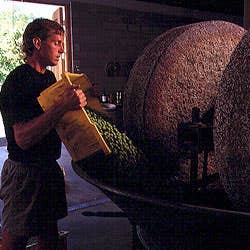
From Olives to Oil
Like winemakers, olive oil producers use different methods to create signature styles and flavors.
Two methods are commonly used to crush olives to produce the thick paste called mash, and then to turn it into bottled oil.
In the traditional method, olives are poured into a circular "maccina," or crusher, in which two vertical stones rotate at about six revolutions per minute. The mash is then placed between stacks of fiber or nylon mats and gently squeezed by a hydraulic press, yielding a mixture of edible oil and oil bound to water. The oil is centrifuged, poured into stainless-steel cylinders, and left to stand for as long as three months. During this period, the liquid is frequently decanted into other cylinders as the solid material settles. Any remaining water is drained from the bottom of the cylinders. Filtering and more centrifuging eliminate any solids that are left. Finally, the oil is bottled.
In the modern method, olives are poured into a stainless-steel vat, where hammers pulverize the fruit. The mash is moved into a large tank, or maxilator, in which it's kneaded by rotating blades, releasing the oil from the paste. Centrifuges and filters separate the paste from the oil and the oil from the water. After three months, the oil is filtered and centrifuged again, and then bottled.
Keep Reading
Continue to Next Story










